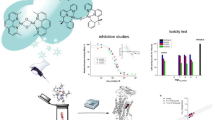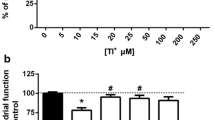Abstract
Toxicological and pharmacological studies demonstrated that the introduction of functional groups into the aromatic ring of diphenyl diselenide alter its effect. The aim of this study was to evaluate the in vitro effect of m-trifluoromethyl-diphenyl diselenide (m-CF3–C6H4Se)2, p-chloro-diphenyl diselenide (p-Cl–C6H4Se)2 and p-methoxyl-diphenyl diselenide (p-CH3O–C6H4Se)2 on δ-aminolevulinate dehydratase (δ-ALA-D) and Na+, K+-ATPase activities in rat brain homogenates. Diselenides inhibited δ-ALA-D activity (IC50 4–6 μM [concentration inhibiting 50%]), and dithiothreitol (DTT) restored the enzyme activity. ZnCl2 (100 μM) did not restore δ-ALA-D inhibition caused by (p-Cl–C6H4Se)2 and (m-CF3–C6H4Se)2. Na+, K+-ATPase activity was more sensitive to (p-Cl–C6H4Se)2 and (m-CF3–C6H4Se)2 (IC50 6 μM) than (p-CH3O–C6H4Se)2 and (PhSe)2 (IC50 45 and 31 μM, respectively). DTT restored the activity of Na+, K+-ATPase inhibited by diselenides. The effect of diselenides on Na+/K+-ATPase is dependent on their substitutions in the aromatic ring. The mechanism through which diselenides inhibit δ-ALA-D and Na+, K+-ATPase activities involves the oxidation of thiol groups.

Similar content being viewed by others
References
Rayman MP (2000) The importance of selenium to human health. Lancet 356:233–241. doi:10.1016/S0140-6736(00)02490-9
Ostadalova I, Vobechy M, Chvojkova Z, Mikova D, Hampl V, Wilhelm J, Ostadal B (2007) Selenium protects the immature rat heart against ischemia/reperfusion injury. Mol Cell Biochem 300:259–267. doi:10.1007/s11010-006-9391-4
Satyanarayana S, Sekhar JR, Kumar KE, Shannika LB, Rajanna B, Rajanna S (2006) Influence of selenium (antioxidant) on gliclazide induced hypoglycaemia/anti hyperglycaemia in normal/alloxan-induced diabetic rats. Mol Cell Biochem 283:123–127. doi:10.1007/s11010-006-2387-2
Nogueira CW, Zeni G, Rocha JBT (2004) Organoselenium and organotellurium compounds: toxicology and pharmacology. Chem Rev 104:6255–6285. doi:10.1021/cr0406559
Painter EP (1941) The chemistry and toxicity of selenium compounds, with special reference to the selenium problem. Chem Rev 28:179–213. doi:10.1021/cr60090a001
Tinggi U (2003) Essentiality and toxicity of selenium and its status in Australia: a review. Toxicol Lett 137:103–110. doi:10.1016/S0378-4274(02)00384-3
Clark RF, Strukle E, Willians SR, Manoguerra AS (1996) Selenium poisoning from a nutritional supplement. JAMA 275:1087–1088. doi:10.1001/jama.275.14.1087
Spallholz JE (1994) On the nature of selenium toxicity and carcinostatic activity. Free Radic Biol Med 17:45–64. doi:10.1016/0891-5849(94)90007-8
Chasteen TG, Bentley R (2003) Biomethylation of selenium and tellurium: microorganisms and plants. Chem Rev 103:1–25. doi:10.1021/cr010210+
Manarin F, Roehrs JA, Prigol M, Alves D, Nogueira CW, Zeni G (2007) Regio- and stereoselective synthesis of vinyl sul.des via PhSeBr-catalyzed hydrothiolation of alkynes. Tetrahedron Lett 48:4805–4808. doi:10.1016/j.tetlet.2007.05.076
Alves D, dos Reis JS, Luchese C, Nogueira CW, Zeni G (2008) Synthesis of 3-alkynylselenophene derivatives by a copper-free sonogashira cross-coupling reaction. Eur J Org Chem 2:377–382. doi:10.1002/ejoc.200700707
Goeger DE, Ganther HE (1994) Oxidation of dimethyl selenide to dimethyl selenoxide by microsomes from rat liver and flavin-containing monooxygenase from pig liver. Arch Biochem Biophys 310:448–451. doi:10.1006/abbi.1994.1191
Farina M, Folmer V, Bolzan RC, Andrade LH, Zeni G, Braga AL, Rocha JBT (2001) Selenoxides inhibit δ-aminolevulinate dehydratase. Toxicol Lett 119:27–37. doi:10.1016/S0378-4274(00)00296-4
Nogueira CW, Soares FA, Nascimento PC, Muller D, Rocha JBT (2003) 2,3-Dimercaptopropane-1-sulfonic acid and meso-2,3-dimercaptosuccinic acid increase mercury and cadmium-induced inhibition of δ-aminolevulinate dehydratase. Toxicology 184:85–95. doi:10.1016/S0300-483X(02)00575-9
Folmer V, Soares JCM, Rocha JBT (2002) Oxidative stress in mice is dependent on the free glucose content of the diet. Int J Biochem Cell Biol 34:1279–1285. doi:10.1016/S1357-2725(02)00065-1
Pande M, Flora SJS (2002) Lead induced oxidative damage and its response to combined administration of alfa-lipoic acid and succimers in rats. Toxicology 177:187–196. doi:10.1016/S0300-483X(02)00223-8
Carfagna MA, Ponsler GD, Muhoberac BB (1996) Inhibition of ATPase activity in rat synaptic plasma membranes by simultaneous exposure to metals. Chem Biol Interact 100:53–65. doi:10.1016/0009-2797(95)03685-7
Folmer V, Santos FW, Savegnago L, Brito VB, Nogueira CW, Rocha JBT (2004) High sucrose consumption potentiates the sub-acute cadmium effect on Na+-K+-ATPase but not on and δ-aminolevulinate dehydratase in mice. Toxicol Lett 153:333–341. doi:10.1016/j.toxlet.2004.06.002
Beal MF, Hyman BT, Koroshetz W (1993) Do defects in mitochondrial energy metabolism underlie the pathology of neurodegenerative diseases. Trends Neurosci 16:125–131. doi:10.1016/0166-2236(93)90117-5
Savegnago L, Trevisan M, Alves D, Rocha JBT, Nogueira CW, Zeni G (2006) Antisecretory and antiulcer effects of diphenyl diselenide. Environ Toxicol Pharmacol 21:86–92. doi:10.1016/j.etap.2005.07.017
Savegnago L, Pinto LG, Jesse CR, Alves D, Rocha JBT, Nogueira CW, Zeni G (2007) Antinociceptive properties of diphenyl diselenide: evidences for the mechanism of action. Eur J Pharmacol 555:129–138. doi:10.1016/j.ejphar.2006.10.003
Ghisleni G, Porciúncula LO, Cimarosti H, Rocha JBT, Salbego CG, Souza DO (2003) Diphenyl diselenide protects rat hippocampal slices submitted to oxygen-glucose deprivation and diminishes inducible nitric oxide synthase immunocontent. Brain Res 986:196–199. doi:10.1016/S0006-8993(03)03193-7
Barbosa NBV, Rocha JBT, Wondracek DC, Perottoni J, Zeni G, Nogueira CW (2006) Diphenyl diselenide reduces temporarily hyperglycemia: possible relationship with oxidative stress. Chem Biol Interact 163:230–238. doi:10.1016/j.cbi.2006.08.004
Meotti FC, Borges VC, Zeni G, Rocha JBT, Nogueira CW (2003) Potential renal and hepatic toxicity of diphenyl diselenide, diphenyl ditelluride and Ebselen for rats and mice. Toxicol Lett 143:9–16. doi:10.1016/S0378-4274(03)00090-0
Rosa RM, Roesler R, Braga AL, Saffi J, Henriques JAP (2007) Pharmacology and toxicology of diphenyl diselenide in several biological models. Braz J Med Biol Res 40:1287–1304
Maciel EN, Flores EM, Rocha JBT, Folmer V (2003) Comparative deposition of diphenyl diselenide in liver, kidney, and brain of mice. Bull Environ Contam Toxicol 70:470–476. doi:10.1007/s00128-003-0010-8
Nogueira CW, Meotti FC, Curte E, Pilissão C, Zeni G, Rocha JBT (2003) Investigations into the potential neurotoxicity induced by diselenides in mice and rats. Toxicology 183:29–37. doi:10.1016/S0300-483X(02)00423-7
Prigol M, Wilhelm EA, Schneider CC, Rocha JBT, Nogueira CW, Zeni G (2007) Involvement of oxidative stress in seizures induced by diphenyl diselenide in rat pups. Brain Res 1147:226–232. doi:10.1016/j.brainres.2007.01.126
Prigol M, Wilhelm EA, Stangherlin EC, Barancelli DA, Nogueira CW, Zeni G (2008) Diphenyl diselenide-induced seizures in rat pups: possible interaction with glutamatergic system. Neurochem Res 33:1573–6903. doi:10.1007/s11064-007-9538-z
Nogueira CW, Borges VC, Zeni G, Rocha JBT (2003) Organochalcogens effects on δ-aminolevulinate dehydratase activity from human erythrocytic cells in vitro. Toxicology 191:169–178. doi:10.1016/S0300-483X(03)00250-6
Pinto LG, Jesse CR, Nogueira CW, Savegnago L (2008) Evidence for the involvement of glutamatergic and GABAergic systems and protein kinase. A pathway in the antinociceptive effect caused by p-methoxy-diphenyl diselenide in mice. Pharmacol Biochem Behav 88:487–496. doi:10.1016/j.pbb.2007.10.006
Paulmier C (1986) Selenium reagents and intermediates. Organic synthesis. Pergamon, Oxford
Sassa S (1982) Delta-aminolevulinic acid dehydratase assay. Enzyme 28:133–145
Jaffe EK (2000) The porphobilinogen synthase family of metalloenzymes. Acta Crystallogr D 56:115–128. doi:10.1107/S0907444999014894
Emanuelli T, Rocha JBT, Pereira ME, Nascimento PC, Souza DOG, Beber FA (1998) delta-Aminolevulinate dehydratase inhibition by 2,3-dimercaptopropanol is mediated by chelation of zinc from a site involved in maintaining cysteinyl residues in a reduced state. Pharmacol Toxicol 83:95–103. doi:10.1111/j.1600-0773.1998.tb01451.x
Barbosa NBV, Rocha JBT, Zeni G, Emanuelli T, Beque MC, Braga AL (1998) Effect of organic forms of selenium on δ-aminolevulinate dehydratase from liver, kidney and brain of adult rats. Toxicol Appl Pharmacol 149:243–253. doi:10.1006/taap.1998.8373
Fiske CH, Subbarow YJ (1925) The calorimetric determination of phosphorus. Biol Chem 66:375–381
Jorgensen PL (1986) Structure, function and regulation of Na+–K+-ATPase in the kidney. Kidney Int 29:10–20. doi:10.1038/ki.1986.3
Björnstedt M, Odlander B, Kuprin S, Claesson HE, Holmgrem A (1996) Selenite incubated with NADPH and mammalian thioredoxin reductase yields selenide, which inhibits lipoxygenase and changes the electron spin resonance spectrum of the active site iron. Biochemistry 35:8511–8516. doi:10.1021/bi9528762
Park HS, Park E, Kim MS, Ahn K, Kim IY, Choi EJ (2000) Selenite inhibits the c-Jun N-terminal kinase/stress-activated protein kinase (JNK/SAPK) through a thiol redox mechanism. J Biol Chem 275:2527–2531. doi:10.1074/jbc.275.4.2527
Gupta N, Porter TD (2001) Inhibition of human squalene monooxigenase by selenium compounds. J Biochem Mol Toxicol 16:18–23. doi:10.1002/jbt.10014
Borges VC, Rocha JBT, Nogueira CW (2005) Effect of diphenyl diselenide, diphenyl ditelluride and Ebselen on cerebral Na+ K+-ATPase activity in rats. Toxicology 215:191–197. doi:10.1016/j.tox.2005.07.002
Tsukamoto I, Yoshinaga T, Sano S (1979) The role of zinc with special reference to the essential thiol groups in δ-aminolevulinic acid dehydratase of bovine liver. Biochim Biophys Acta 570:167–178
Santos FW, Zeni G, Rocha JBT, do Nascimento PC, Marques MS, Nogueira CW (2005) Efficacy of 2, 3-dimercapto-1-propanesulfonic acid (DMPS) and diphenyl diselenide on cadmium induced testicular damage in mice. Food Chem Toxicol 43:1723–1730. doi:10.1016/j.fct.2005.05.015
Brandão R, Borges LP, de Oliveira R, Rocha JBT, Nogueira CW (2008) Diphenyl diselenide protects against hematological and immunological alterations induced by mercury in mice. J Biochem Mol Toxicol 22:311–319. doi:10.1002/jbt.20242
Acknowledgments
The financial support by Universidade Federal de Santa Maria (UFSM), Fundação de Amparo à Pesquisa do Estado do Rio Grande do Sul (FAPERGS), Coordenação de Aperfeiçoamento de Pessoal de Nível Superior (CAPES) and Conselho Nacional de Desenvolvimento Científico e Tecnológico (CNPq) is gratefully acknowledged. C.A.B, C·W.N and G.Z. are recipients of CNPq fellowships.
Author information
Authors and Affiliations
Corresponding author
Rights and permissions
About this article
Cite this article
Brüning, C.A., Prigol, M., Barancelli, D.A. et al. Disubstituted diaryl diselenides inhibit δ-ALA-D and Na+, K+-ATPase activities in rat brain homogenates in vitro. Mol Cell Biochem 332, 17–24 (2009). https://doi.org/10.1007/s11010-009-0169-3
Received:
Accepted:
Published:
Issue Date:
DOI: https://doi.org/10.1007/s11010-009-0169-3




